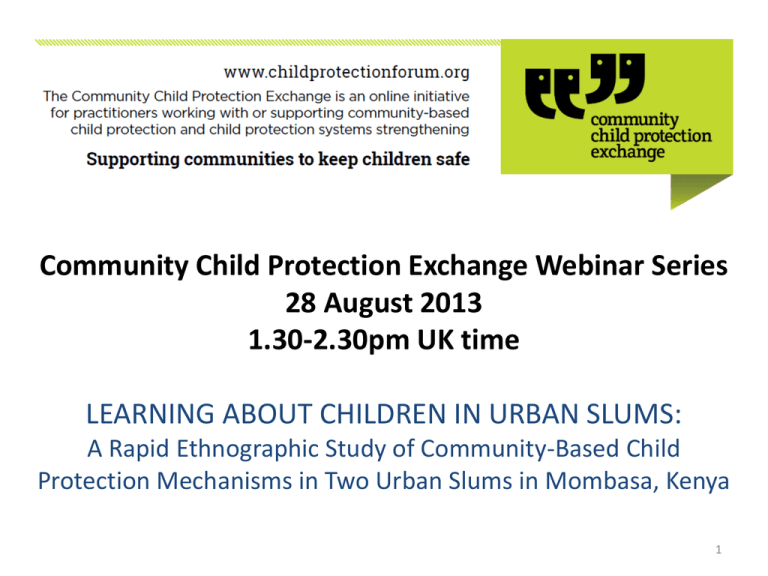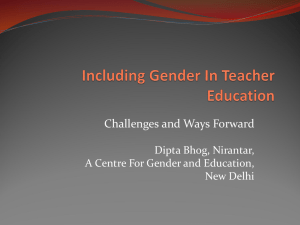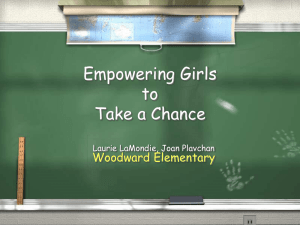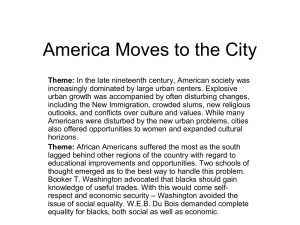
Community Child Protection Exchange Webinar Series
28 August 2013
1.30-2.30pm UK time
LEARNING ABOUT CHILDREN IN URBAN SLUMS:
A Rapid Ethnographic Study of Community-Based Child
Protection Mechanisms in Two Urban Slums in Mombasa, Kenya
1
The Inter-Agency Learning
Initiative
Widespread NGO and government use of community Child
Protection Committees and Child Welfare Committees
Questions about effectiveness, sustainability, relation to
existing community groups and wider child protection systems
2010 Global Desk Review
Multi-stage learning in Sierra Leone and Kenya
Bottom-up approach to systems strengthening—testing the
effectiveness of community driven interventions for
strengthening linkages between community based child
protection mechanisms and formal mechanisms
Global Reference Group
ChildFund
International
CPWG
Human Sciences
Research Council
IICRD
Save the Children
Terre des Hommes
Tostan
TPO Uganda
UNICEF
USAID DCOF
PEPFAR
War Child Holland
Watchlist on Children
in Armed Conflict
World Vision
Mike Wessells, Kathleen Kostelny, Ken Ondoro
and Jemaiyo Chabeda-Barthe
Inter-Agency Learning Initiative on Community-Based Child
Protection Mechanisms and National Child Protection systems
Funded by PEPFAR
4
Overview of Kenyan Work
Research sites in Mombasa, Kilifi, and Nyanza
Highly consultative process with diverse Kenyan
stakeholders
Importance of diversity (e.g., urban-rural)
Emphasis on strategic value added and filling gaps
Attention to all vulnerable children
Development of population-based outcome indicators and
measures for children’s risks and well-being
Quasi-experimental design for testing a community-driven
linking intervention
5
Kenyan Partners
UN/NGO: UNICEF-Kenya, Action Aid International,
AMREF, ANPPCAN, APHIA PLUS, CARE, CEFA, Child Line,
CLAN, CRADLE, Girl Child Network, IRC, KAACR, Plan
International, Save the Children, and World Vision
Government: Department of Children’s Affairs, Area
Advisory Council, District Children’s Officer, Chiefs, and
Elders
National Research Team: Jemaiyo Chabeda-Barthe (Lead
Ethnographic Researcher) and Ken Ondoro (Team Leader),
Michael Mbaru, Maud Saka, and Tracy Saka
Youth, children, women, community people
6
7
Mombasa Research:Two Urban Slums
(Informal Settlements)
Importance of learning about urban areas
- rapid urbanization globally
- urbanization of poverty
- concentration of very poor people in slum areas
- less known about child protection in urban areas
Giriama—in Bangladesh slum
Mskitini—in Tudor Moroto slum
Approximately 90% Christian
Chronic poverty
Mixed ethnicity—Luo, Luhya, Giriama, Kamba
8
Rapid Ethnography of CBCPMs
The ‘Listening Gap’ and reliance on preconceived categories
Useful in learning about and documenting local beliefs,
values, and practices in a culturally grounded manner
Building trust—key in alleviating suspicion and enabling
collection of accurate data
Timeframe: July-August, 2012
National researchers lived and worked in the slums for one
month or more
Reaching women, men, teenage girls & boys, ‘non-elites’
9
Key Questions:
Who is a child and how do children develop?
What are the main harms to children, aside from poverty
and health issues? How do they vary by gender, age, SES?
What protective factors support children?
What endogenous and exogenous protection mechanisms
and practices are used?
When and how do people use the formal child protection
system?
What barriers are there to the use of the formal aspects of
the child protection system?
10
Research Design and Participants—
Contrasts by Age, Gender, SES
Women: Age 25 years and above
Young women (‘makamu’ of marrying age): Age 18-25 years
Teenage girls: Age 13-17 years
Young girls: Age 5-12 years
Men: Age 30 years and above
Young men (typically not married): Age 18-30 years
Teenage boys: Age 13-17 years
Young boys: Age 5-12 years
Lower and higher SES (70% vs. 30%): based on criteria of
housing material, house size, location, source of income,
type of foods eaten
11
Mapping of Pathways of Response
When problem X occurs, what happens—who responds
or who does child go to for help?
What are the steps involved?
Who makes the decisions and who is consulted?
What are the decisions taken or outcomes?
How do different stakeholders (parents, family,
community, child) view the outcome?
12
Research Tools
Participant observation & living in villages
Group discussions—risks and pathways,
preventive factors
In-depth interviews
Key informant interviews: Government, NGO
workers, and local leaders
Timelines: childhood, markers, roles
Risk mappings and Body mappings: learning
from younger people
13
Who Are Children?
A child is 2-12 years.
A child is less than 15 years.
A child is anyone who does not know how to look for
food and depends on the mother for everything.
(Adult women, group discussion, Msikitini)
To say that this is a child, you look at his brain, his
thoughts, his behavior and his age. So a child is
from 1 month to 5 years. (Young woman, Msikitini)
14
Local Views of Harms to Children
‘Most serious’ harms
Additional harms
Out of school children
Hard work
Sexual abuse and
Neglect
exploitation
Early pregnancy
Alcohol and drugs
Bad peer influence
Karata (gambling)
Child beating
Witchcraft
15
QUESTIONS?
16
17
Most Serious Harm to Children
18
Most Serious Harm by Slum Area
19
SES Effects on Ratings of the Most
Serious Harm to Children
20
Out of School Children
Just to add on the issue of chang’aa, you find that the mother tells the boy child
that you have to ‘boil’ [chang’aa] and get money. So when the child starts to
‘boil’ he also starts to touch money and he loses interest in going to school.
The parents also, especially the Giriamas, do not take their children to school so
they remain idle the whole day and that’s why they get pregnant. Why is it that
our children from upcountry do not get pregnant as easily as the ones from
Giriama? (Adult women, group discussion, Msikitini)
Some children just refuse to go to school. At times the teacher beats the child in
school to the point that that child refuses to go school. (Adult women, group
discussion, Giriama)
Out of school boys often picked scrap. Having earned money, they were
reluctant to return to school even if they had the opportunity to return.
21
Sexual Abuse and Exploitation
There are also other people who give children money and every now and then,
they keep on buying for them “viazi” for ten shillings. Later on, they call
these children inside their houses and start touching them on their private
parts. (Adult man, in-depth interview, Gariama)
When your mother dies and then you are taken to stay with your uncle, the
uncle will now be the person who buys you everything…. Then after some
time, the uncle comes to you and tells you that you have to sleep with
him…(Teen girls, Msikitini)
There are parents who use their girls to attract customers and sometimes sell
the girls to the customers in exchange for money. (Women, Giriama)
Girls frequently stay in school by allowing abuse by an uncle who pays fees
Differences by gender (‘jig jig’) and religious orientation
22
Ratings of Sexual Abuse and Exploitation
Among Top Three Harms by Different Sub-Groups
23
Early Pregnancy
There are girls who go to the disco at night and they meet men there,
have sex with them and then they get pregnant and drop out of
school. (Teen girls, Msikitini)
Disco matanga is a major harm to children in this community. This
place is where most of the evil takes place like rape, alcoholism, sex,
girls and boys get infected with HIV, girls get pregnant, boys and
girls smoke bhang and such like things. (Adult woman, Giriama)
And because children have no food, young girls get pregnant early in
life. They are cheated with just 20 shillings to buy food and they get
pregnant. (Pastor, Giriama)
24
HIV and AIDS
HIV/AIDS was reportedly widespread , yet HIV-positive people were
badly stigmatized
HIV and AIDs are big issues here. Drugs too are a major issue. Some
children when they get home and find there is no food, they go and
start having sex for money. They are given fifty shillings or one hundred
for having sex with an old man, and with this they buy food…. Many
teenage girls do this and many have HIV. If we go door to door, you will
find many. (Adult men’s group, Msikitini)
When a child is raped she may also contract the disease. Apart from rape
most children here engage in careless sexual behaviors and as a result
there is widespread cases of AIDS in this area. (Adult women group,
Msikitini)
25
Alcohol and Drugs
In other cases, you find the mother of the child is the one who brew
chang’aa and then child keeps on tasting. This child will grow up
with alcohol because he keeps on tasting and before he even
becomes an adult, he is already a drunkard. (Adult man, in-depth
interview – Giriama)
There are children who also smoke bhang, smoke and drink alcohol
and all these is as a result of the group influence. If your child has
joined a bad group then the others start telling him or her that
drinking and smoking are good and he ends up doing the same.
(Adult man, in-depth interview Giriama)
When we use them, it harms us and sometimes makes the person
go crazy or starts talking to him in the streets. However, that is not
his wish, but he is just using drugs so that he frees himself from
stress. … (Teen boys, Msikitini)
26
Dislikes of Young Children
Five to eight years
Smelling and touching
feces
Eating ‘dirty’ or ‘rotten’
food
Hearing abuses
Being shouted at
Being hit on head,
hands, or feet
Hearing people fighting
Nine to thirteen years
Alcohol and drugs
Seeing people who had
been beaten, burned,
stabbed, or killed
Hard work such as
picking scrap, fetching
firewood, or washing
clothes
Seeing children being
raped (Giriama)
27
Preventive Factors
Family
Being in school
Religious groups and leaders
Youth group: Alpha and Omega
Women’s groups: ‘Merry Go Round’
Variations by SES
Preventive factors were strained or
overwhelmed by the burden of
accumulating risks
28
Response Pathways
For 70-80% of harms to children, the response was through
nonformal family and community mechanisms
Pathways of response were particularly weak in regard to
sexual abuse within the family
Family honor and avoidance of shame were often
prioritized over the well-being of girl survivors of sexual
abuse
‘Traditional’ mechanisms such as traditional courts or
councils of elders were rare to nonexistent
29
Linkage of CBCPMs
With the Formal System
Functional linkages existed through Volunteer Children’s
Officers, Chiefs, Elders, and the Police
Area Advisory Councils (AACs) are potentially useful in
bridging formal and nonformal child protection supports
Some referrals did occur through Children’s Officers
Overall, however, the linkages were weak
Two-thirds said people were unwilling to report a case of
stranger rape of a child to the police
Obstacles to the use of the formal system:
- view of police as corrupt
- concern that reporting will not lead to action
- wanting to avoid suspicion or discord with the community
- taboo to report family members
30
Non-reporting of Sexual Abuse
by a Family Member
Because that is a family affair and the uncle can be called and asked why
he has done that. Then he can be told to stop it…. That’s a family issue.
(Adult women, Giriama)
If it is the father raping a child, I won’t even bother because that is
family matter. Let them solve it like a family. (Young men, Giriama)
The rapist might be the bread winner in the family. If he gets arrested,
people will suffer in the family. I might end up dropping out of school
because there will be no one to pay my fees. In fact, that is family thing
that people outside the family should not even know. It should be kept a
secret. (Young men, Giriama)
31
QUESTIONS?
32
33
Reflection
The urban slums are highly toxic environments for
children. Children have learned to navigate these
environments yet urgently need support.
Low social cohesion makes it difficult to create a
protective environment for children. Humanitarian
efforts will need to work in ways that strengthen social
cohesion.
Although the preventive factors are overstretched and
outweighed by accumulating risk factors, they are
assets to build upon.
34
Sexual abuse and exploitation were widespread
and require immediate action
Recommendations:
(1) Child protection practitioners and stakeholders
should urgently attend to problems of sexual abuse
and exploitation in association with discos, disco
matangas, the sale of chang’aa in the home, and drug
and alcohol abuse; and
(2) Child protection practitioners' and stakeholders'
efforts should focus on preventing sexual abuse and
exploitation in the family through strengthening
parenting skills and family care of children.
Link work on sexuality, livelihoods, and land rights.
Test and document intervention strategies .
35
Views of harms to children varied
according to SES, age, and gender
Recommendations:
(1) Practitioner assessments of child protection risks,
resources, and mechanisms in the slums should use child friendly
methods in order to include, compare, and contrast the voices
and perspectives of girls and boys at different stages of
development and from high SES and low SES families;
(2) Practitioners should make girls’ and boys’ voices and views
central in discussions of what are appropriate, desired outcomes
of child protection mechanisms and the wider national child
protection system;
(3) Practitioners should not use ‘one size fits all’ programs for
children living in the slums and should tailor interventions in a
manner that meets the needs of different subgroups; and
(4) Practitioners should support a process of dialogue and
increased understanding between children and adults on issues
of child protection and well-being.
36
Being out of school served as a gateway to
exposure to additional risks, whereas being in
school was a significant preventive factor
Recommendations:
(1) NGOs and civil society groups should strengthen advocacy efforts
with schools and the Kenyan Government to ensure that vulnerable
families are exempted from having to pay school related levies for their
children;
(2) The Kenyan Government, NGOs, and community groups should
provide livelihood supports such as access to social protection for
vulnerable families in child friendly ways that improve children’s access
to schools and health care;
(3) Practitioners should build on existing assets for preventing children
from being out of school and encouraging children to stay in school.
These should include the nonformal aspects of the child protection
system such as parents, religious groups, and women’s groups.
(4) The Kenyan Government should prioritize efforts to strengthen the
schools as a protective environment for children, including the use of
positive methods of discipline and the provision of sanitary towels for
girls.
37
Important preventive factors such as religion
existed in the slums, even for the poorest people
Recommendations:
(1) Practitioners should include in assessments a mapping
of preventive factors and other assets for different subgroups of children, recognizing that the preventive factors
may not be conspicuous in urban slums;
(2) Practitioners should engage and collaborate with
religious leaders, women’s groups, and youth groups in the
slums in preventing harms to children;
(3) Practitioners should make prevention a high priority
in programming by building on and strengthening existing
preventive factors.
38
Significant gaps existed between
international child rights standards and
local views of children and harms to children
Recommendations:
(1) A high priority for the Kenyan Government and
practitioners should be to reduce the widespread use
of harsh corporal punishment that is evident in both
the formal and nonformal domains of child
protection;
(2) Practitioners should train parents on positive
methods for disciplining children and support local
groups in advocating for the use of positive methods;
(3) Practitioners should use respectful, dialogue
oriented processes to introduce ideas of child rights
and child responsibilities, with engagement of adults
as well as children.
39
In addressing harms to children, people relied
extensively on endogenous, nonformal mechanisms
of child protection that need additional support
Recommendations:
(1) Practitioners should identify and support the
endogenous child protection mechanisms in the slums
as a means of preventing harms to children and
supporting children’s well-being;
(2) Practitioners should strengthen appropriate
linkages between CBCPMs in the slums and other
parts of the national child protection system,
including formal aspects of the system through
community-driven action.
40
Significant social and cultural obstacles impeded the
use of the government led aspects of the national child
protection system
Recommendations:
(1) The Kenyan Government should strengthen the
accountability and effectiveness of the formal aspects of
the national child protection system. One means of doing
this could be to have the AACs monitor the effectiveness of
the formal system elements that are accessible to people in
the slums and report the results to NGO partners, who
could then advocate with Government partners for
improvements in the formal aspects of the system;
(2) Practitioners should use a patient, internally guided
process of changing social norms to address the cultural
and social obstacles to the use of the formal aspects of the
national child protection system.
41
Closing Reflection
The success of the Kenyan national child protection
system should be gauged in part by how well it cares
for and protects the most vulnerable children,
including those who live and grow up in urban slums.
42
43
44






